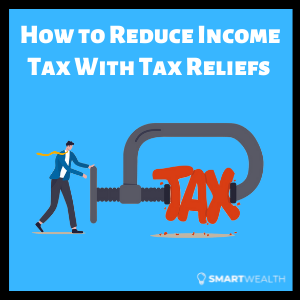One of the most certain things in life is this: You cannot run away from paying income tax.
Every April, all working Singaporeans will be busy filing their taxes – and some really feel the pinch especially if they have made substantial earnings that year.
The income tax is not fixed – it progressively increases as you earn more annually.
According to IRAS’s tax calculator, you need not pay taxes on the first $20,000 you earn. The next $10,000 of income will incur 2% tax. And the tax rate increases the more you earn. The highest personal income tax rate is pegged at 22%, and this is for those who earn more than $320,000 per annum.
However, there are 15 ways you can reduce the total income tax legally. Before we dive into these 15 methods, you will need to understand what tax reliefs and tax rebates are.
What Are Tax Reliefs (& How Do They Reduce Income Tax)?
Tax reliefs are deductions made by IRAS on your total payable income tax.
Interestingly, this scheme was designed by the government to “encourage social and economic objectives such as filial piety, family formation and the advancement of skills.”
Tax deductions thus cover the following fronts: donations to registered charities, contributions to family, and various economic contributions to the nation.
These deductions are made against your assessable/chargeable income, including rental income and other income that may come in from your side hustles. However, the total amount of relief you can claim is $80,000.
SIDE NOTE When was the last time you conducted thorough financial planning or reviewed your finances? In this day and age in Singapore, doing so will absolutely improve the quality of life for you and your loved ones. Here are 5 reasons why financial planning is so important.
Difference Between Tax Reliefs and Tax Rebates
IRAS also has tax rebates.
Tax rebates, unlike tax reliefs, are not guaranteed, and they function exactly as rebates – the money will be calculated and can offset your payable income tax.
They are dependent on the government’s decision on the year of assessment. For example, in 2019, the government decided that as part of the Bicentennial Bonus, a tax rebate of up to $200 will be granted to all tax residents.
The other tax rebate available is for parents. The Parenthood Tax Rebate (PTR) is to encourage more Singaporeans to have children. Each parent can only claim for a qualifying child once, up to $20,000. $20,000 is a lot of money – but do note that this is only applicable for parents who have had their 5th child (and more).
The Various Tax Reliefs in Singapore
Thankfully, you don’t have to become a parent of 5 kids to reduce your income tax. IRAS has a variety of ways to claim tax reliefs. You can find the relevant methods that apply to you below.
Take note that the information below only provides an overview. If you want to learn more about them, do click on the links which lead to their relevant pages on IRAS.
Building up retirement funds
The Singapore government has often reiterated the importance of being able to fund your own living.
To encourage this habit of savings and being able to have a big enough stash to tide you through the years, tax relief is offered to those who actively build up their retirement funds in 3 following ways: CPF Cash Top-Up Relief, Contributions to MediSave Account, and the SRS Relief.
CPF Cash Top-Up Relief
The CPF Cash Top-Up Relief is one way to build up both your and your parents’ retirement fund, and get income tax relief. It doesn’t just apply to parents, but to other family members such as your grandparents, spouse, and siblings. One condition that must be met is that the top-up has to be from your own cash, not a transfer made from one CPF account to another. As long as you do a top-up to your or your parents’ Special Account or Retirement Account, you are eligible to get tax relief. You are able to claim up to $7,000 in CPF Cash Top-Up Relief for yourself and an additional $7,000 in reliefs when you top up for your family members.
Voluntary Contributions to MediSave Account
Another method is to make a voluntary contribution to your MediSave Account. This may be especially attractive to self-employed persons and those who want to beef up their MediSave account balance. There are several requirements to fulfill before being able to claim your tax relief for this, and it is important to read the IRAS guidelines especially as there is a ceiling for this contribution.
SRS Relief
The SRS (Supplementary Retirement Scheme) relief is probably the most attractive out of the 3. The tax relief is the actual amount contributed to your SRS (up to limits). However, before making such a decision, you would need to consider if you are okay with leaving your money in there until you are 62 years old as there are limitations with withdrawals. You can learn more about the SRS here.
Having kids
To encourage more families to have children, Singapore gives attractive tax reliefs for parents. There are a total of 5 types of tax reliefs for Singaporeans.
For Male and Female Taxpayers
Qualifying/Handicapped Child Relief
Parents can claim tax relief for each child until they start earning their own income and are above 16 years of age. The tax relief is limited to $4,000 per child. For those with handicapped children (physical or mental), parents can claim tax relief of $7,500 per handicapped child.
Spouse Relief/Handicapped Spouse Relief
For spouses who are supporting the family on one income, the working spouse can claim tax relief of $2,000. For those who are supporting a handicapped spouse, you can claim $5,500. If you are legally separated and give a maintenance allowance to your spouse, you are also eligible for some of this tax relief.
For Female-Only Taxpayers
Female taxpayers have 3 additional methods of claiming tax reliefs.
Working Mother’s Child Relief
All working mothers who have earned income are eligible for the Working Mother’s Child Relief. This is based on a percentage of your income, and the amount of tax relief claimable increases as you have more children. However, there is a limit of $50,000 claim per child (including the Qualifying Child Relief), and the general tax relief cap of $80,000 still applies.
Foreign Domestic Worker (FDW) Levy Relief
Working mothers are also able to claim twice the total amount of levy paid for one FDW. The levy rate for the first FWD is $300/month.
DID YOU KNOW? According to a survey conducted by MoneySense, about 3 out of 10 Singapore residents aged 30 to 59 had not started planning for their future financial needs. This isn't surprising because personal finance can seem complicated and daunting. But really, there are only a few things that you should focus on. Learn how to significantly improve your personal finances with the 7-step "wedding cake" strategy today.
Grandparent Caregiver Relief
For those who involve their parents or parents-in-law in caregiving of the child, you are able to claim the Grandparent Caregiver Relief of $3,000, if the grandparent does not earn any other income for that year, along with other conditions. However, this is only applicable to mothers who are working.
Taking care of your family members
You can also claim tax reliefs for looking after your family members. The government rewards those who practice filial piety.
Parent Relief/Handicapped Parent Relief
If you are supporting your parent living in the same household, you can claim tax relief of up to $9,000. However, your parent must fulfil some conditions: they are above 55 years of age, do not have an income of more than $4,000 for that year. For those with handicapped parents, you can claim up to $14,000 for that year.
Handicapped Brother/Sister Relief
The handicapped brother/sister relief is applicable also for those who are supporting their brother or sister-in-law. To be eligible for this tax relief, you must submit the relevant medical documents, have proof that the sibling/sibling-in-law is living in Singapore and you have contributed at least $2,000 to support him or her (or he/she is living with you). The tax relief is capped at $5,500.
Others
Earned Income Relief
All working persons are eligible for earned income relief. Those below the age of 55 can claim $1,000. For those aged 55-59, the claim goes up to $6,000. For those aged 60 and above, the claim is capped at $8,000. Handicapped persons who earn an income will receive higher tax relief.
CPF Relief
The CPF relief is only claimable for compulsory employee CPF contributions and voluntary contributions to your MediSave. As there are many conditions involved, do take a look at the IRAS page.
NSman-Related Reliefs
The NSman related reliefs apply to those who have completed serving NS, are married to NSmen, or are parents of NSmen.
The NSman (Self) Relief is given to all NSmen. Those who have served for the preceding year of assessment can claim $3,000, while those who have not can claim $1,500. Key appointment holders are entitled to higher reliefs.
In recognition of the sacrifices made to support NSmen, spouses and parents are also able to claim tax relief. The total NSman wife relief and NSman parent relief is $750 each. Parents who have more than one son who has completed serving NS will only be able to claim $750.
Life Insurance Relief
The life insurance relief is applicable for those who fund their own life insurance policies. This does not include accident plans and health policies. This also excludes government-related insurance policies such as MediShield Life, CareShield Life and ElderShield.
Most people will find it difficult to claim for this tax relief as apart from having to fulfil the requirements stated above, you must not have more than $5,000 of contribution in both your compulsory and voluntary contribution to your CPF.
Course Fee Relief
In line with the government’s emphasis on life-long learning and upskilling, IRAS provides a special course fee tax relief for professionals who pursue courses related to their profession (and not taken as a hobby or for leisure). However, this is not applicable to professionals who take courses paid for by their company. The course fee relief is $5,500.
Making a Donation to an Approved Charity
To encourage greater contributions to the community, the Ministry of Finance has extended a 250% tax deduction on all approved charities until 2023. For those who contribute more than their own income for the year, the tax deduction can be rolled over to the years after up to 5 years. You would not have to e-file a claim as these will be reflected automatically in the tax assessments for the year.
Final Thoughts
As most of these methods require e-filing, you should set aside some time every April to ensure that you have accurately filed for all the tax reliefs you are eligible for. This can reduce the amount of income tax payable by quite a substantial amount.


